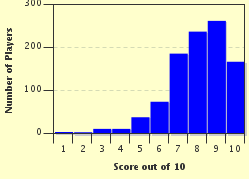Quiz Answer Key and Fun Facts
1. Chile is located on the west coast of South America. How would you briefly describe the shape of Chile?
2. About 80% of the terrain of Chile is mountainous. What mountain range, which runs the length of the continent, stretches through the entire country of Chile, forming its eastern boundary?
3. Chile has a number of volcanoes, due to the subduction of the Nazca and Antarctic Plates underneath the South American Plate. Because of this, Chile is often said to be part of what region?
4. Along with volcanoes, Chile's geologically active condition means that it often experiences another seismic phenomenon. What event off the coast of the Maule region on February 27, 2010 was noticed by residents in the six regions that contain over three-quarters of the Chilean population?
5. The landscape of Chile is not all mountains. In the north of Chile you will find one of the world's driest regions. What is it called?
6. Lying between the Chilean Coast Range and the Andes, and extending from latitude 32S to 36S, is the Chilean Central Valley. Which major Chilean city is located in this region?
7. Bounded on the north by the Bio-Bio River and on the south by the Chacao Channel is Chile's Southern Zone, which contains one of the rainiest regions in the world. What is this area's nickname, which is reminiscent of a part of the United Kingdom?
8. The southernmost portion of mainland Chile is in a region (shared with neighbouring Argentina) called Patagonia. Which of the following best describes the landforms of Chilean Patagonia?
9. A Spanish expedition led by the Portuguese explorer Ferdinand Magellan discovered a (barely) navigable passage between the Atlantic and Pacific Oceans just south of South America. The Strait of Magellan lies between mainland South America and what island archipelago shared by Argentina and Chile?
10. Chile does not confine its territory to the mainland of South America. Which of the following is NOT an island territory claimed by Chile?
Source: Author
looney_tunes
This quiz was reviewed by FunTrivia editor
Pagiedamon before going online.
Any errors found in FunTrivia content are routinely corrected through our feedback system.

